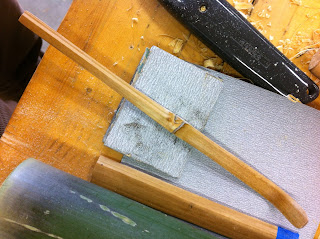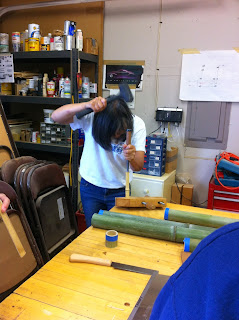Nov 26, 2013
Competency in the tea room
Here is the news: we all feel like we have to start all over again. In fact, for those of us who have practiced for 25 years and more, we want to get back to the place where we feel like beginners again. Rikyu's poem says, "Learn from one to ten and then return to the original one again." The change of the seasons reminds us to pay attention to what we are doing.
Feeling competent in the tea room can lead to feeling complacent -- to phone it in because we know what to do. My sempai said that as a host, the act of making tea is brand new every single time you do it. To have the freshness, anticipation and excitement of doing something as if for the very first time, makes it fresh and new for the guests, too.
With the many variations in temae, depending on the guests, the utensils, the seasons, the time, the place, there are literally millions of ways to perform the ceremony. Who can remember and do each one perfectly? Does doing the temae perfectly mean you are competent? Can you do a competent temae without doing it perfectly?
Can we this apply to real life outside the tea room? There are no instructions for life, so how do you judge how competent you are doing your life? Do you get to practice life until you feel competent?
Nov 25, 2013
Samurai! at the Portland Art Museum
Samurai armor from the Ann and Gabriel Barbier-Mueller Collection will be on display until January 12, 2104

Travel back in time and discover remarkable objects that illuminate the life, culture, and pageantry of the samurai, the revered and feared warriors of Japan—from one of the finest and most comprehensive collections in the world. Samurai! Armor from the Ann and Gabriel Barbier-Mueller Collection presents a treasure trove of battle gear made for high-ranking warriors and daimyo (provincial governors) of the 14th through 19th centuries. The exhibition illustrates the evolution of the distinctive appearance and function of samurai equipment through the centuries and examines their history.
During the centuries covered by the exhibition, warfare evolved from combat between small bands of equestrian archers to the clash of vast armies of infantry and cavalry equipped with swords, spears, and even matchlock guns. Arms and armor were needed in unprecedented quantities, and craftsmen responded with an astonishingly varied array of armor that was both functional and visually spectacular, a celebration of the warrior’s prowess. Even after 1615, when the stern rule of the Tokugawa military dictatorship brought an end to battle, samurai families continued to commission splendid arms and armor for ceremonial purposes. Because the social rank, income, and prestige of a samurai family were strictly determined by the battlefield valor of their ancestors, armor became ever more sumptuous as the embodiment of an elite warrior family’s heritage.
Drawn from the renowned Ann and Gabriel Barbier-Mueller collection, Samurai! features the full panoply of warrior regalia, with full suits of armor, helmets and face guards, weapons, horse trappings, and other battle gear. Highlights include helmets of lacquered metal adorned with emblems often inspired by nature—which signaled the status of the wearer, differentiated samurai from each other, and also frightened the enemy on the battlefield; armored horses carrying combat-ready samurai; and a full ensemble of armor and ceremonial jackets worn by the high-ranking samurai of the Mōri family. The Mōri, who traced their roots to famous warriors of the13th century, were among the most powerful warrior families in western Japan. Portland will be the only West Coast venue for Samurai!
Nov 24, 2013
Art Over MacLeay Park
For those of you in Portland, I will be showing all new handbags at Art Over Macleay Park, December 7-8th. please come and look at the wonderful things for sale. You just might find the right gift for Christmas and indulge yourself with a SweetPersimmon leather handbag as well.
Nov 23, 2013
Disaster in the tea room
She came up with one I had to deal with a couple of months ago that I would like to share with you.
Question: What happens when there is a disaster in the tea room?
I was thinking and thinking of the last disaster I had in the tea room, and how I handled it. There was the Seattle earthquake in 2001. It was a 6.8 magnitude and did considerable damage to buildings and rocked for what seemed like a long time. But I was at work when it happened, and since we couldn't get cars out of our underground garage, several of my co-workers walked with me to my house, and I made tea for them to calm everyone down.
With all of the other natural and manmade disasters in the world; hurricanes, typhoons, flooding, earthquakes, oil spills, nuclear; it seemed like a reasonable question to me. However, I decided to probe a little for what was on her mind.
Question: What do you mean by disaster?
Question: Well what happens, for example, when someone spills tea on the tatami mats?
Answer: Well then, they would clean it up!
Nov 22, 2013
From the archives
I have been going back through the archives and hope you will want to review some of the articles there; too. I cannot believe it has been 6 years of blogging, either.
1 year ago
Tis the Season
2 years ago
Month of Teachers Running
3 years ago
The season for Udon
Trust the process
4 years ago
Back to the Beginning
Senke Jusshoku, ten craft families
5 years ago
Do, Gaku, Jistu revisited
Okeiko, considering the past
25 things chado, the way of tea has taught me
6 years ago
The sounds of the tea room
The language of kimono
Japanese for the tea room
The samurai and the tea master
Nov 21, 2013
Catching up
As promised here are some of the other activities from this fall: (warning another image heavy post.
In October I went to the Northwest Tea Festival in Seattle. There were a lot of tea enthusiasts and presentations and tea tastings. While in Seattle we visited a few of the tea shops as well.
Whew! that's a lot of photos. And we are not done yet. Please look at the left sidebar to see other activities for the rest of the year.
Nov 19, 2013
Activities at Issoan
For my blog readers, I apologize for not posting. It seems like I do this periodically - get out of the habit of blogging and then let it go for a while. I will do better in the future.
Let's see, we have been busy this summer. To begin with we have had a workshop or special event since August. (Image heavy post follows) Here are some photos from the chashaku carving and bamboo hanaire making workshop
Whew, that's a lot, but we still have more to come....I'll post them tomorrow.













































